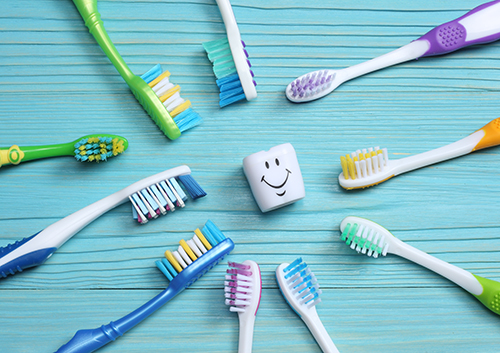Healthy Gums and Older Adults
May 9th, 2024

One of the most important parts of staying healthy as we grow older is being open to learning new ways of staying healthy! While worrying about braces or wisdom teeth might be a thing of the past, there are new dental concerns that come with mature years. Taking care of our gums is one way to maintain not only our dental health, but to look out for our overall health as well.
- Periodontal disease is preventable for older adults
While gum disease is all-too-common among older adults, it isn’t really a result of the aging process itself. If you have been keeping a regular schedule of brushing and flossing (two minutes twice a day), and have been making routine visits to our office for exams and cleaning, you probably have avoided gum disease. But if you have been neglecting your dental care, gingivitis and periodontitis are conditions that only become more serious over time.
The first symptoms of gingivitis include puffy, swollen gums that may bleed easily. Persistent bad breath and changes in the bite or the fit of dentures are also indications of gum disease. As gum disease progresses it leads to periodontitis. The gum tissue pulls away from the teeth, leaving deep pockets of tissue where plaque can collect and infections can develop. Infection, left untreated, can lead to loose teeth and even bone and tooth loss.
The good news? It is never too late to treat gum disease. Most gingivitis is reversible, and modern periodontal treatment makes use of deep cleaning, antibiotics, and even gum surgery to restore gum health. Don’t let past neglect lead to future tooth loss. We are happy to see you any time to treat your gums and teeth and to let you know ways to protect them for a happy, healthy future.
What new concerns do we face as we age?
- Our gums recede.
This natural recession can lead to the exposure of the root areas of the teeth, which are more vulnerable to cavities. It’s very important to keep up with brushing, flossing, and regular check-ups to catch potential small problems before they become big ones.
- Old fillings and dental work can break down.
Call our Anthem office any time you notice a problem with a filling, and keep up with exams, where we can pinpoint fillings that need replacement and detect cavities that can develop near the edges of old work.
- Medications can cause side effects that affect our gums.
Some medications cause the growth of puffy gum tissue. Some can cause dry mouth, which can lead to gum disease. Always let us know about any health conditions you have or medications you may be taking. We can suggest a number of options to reduce or eliminate effects on your mouth and gums.
- Gum health and our overall health—what’s the connection?
While no one has discovered an absolute relationship between gum disease and other health problems, there is growing evidence that higher rates of diabetes complications, heart disease, and stroke are linked to higher levels of gum disease. Make your medical and dental health a priority.
- Smoking risks increase with age.
Studies have shown smokers have not only a greater risk of gum disease, but more severe gum disease as well. Your risk of developing oral cancer also increases with every year you smoke. It is never too late to quit! Talk to us about suggestions for breaking the habit once and for all, and be sure to keep up with regular checkups for early detection and treatment of any oral diseases caused by smoking.
Please let us know any changes that have taken place in your dental habits, medical condition, or medications. Talk to us about any periodontal concerns you may have, or the latest dental procedures we offer for gum care and treatment. We can let you know about products that can make brushing and flossing easier as you age.
It’s never too late or too early to think about taking care of yourself. We are happy to offer suggestions for maintaining or restoring your dental health that will serve you well in any chapter of your life.
What's the best dental floss?
May 2nd, 2024

Dental floss is similar to a lot of products that depend mainly on the consumer’s preference. Fact is, floss comes in a wide variety of flavors, coatings, and other variations, but all types of floss essentially do the same thing. After all, that is what is most important: that the dental floss you buy is functional—cleaning the areas in between your teeth. If you want to know what the best dental floss is, the answer is the kind that enables you to successfully and regularly clean those areas. So to help you find the right type of floss for you, here are some options.
Flavored Dental Floss
Many people that floss prefer a flavored dental floss because it freshens their breath even more than unscented floss. The latter can also take on the smells associated with bacteria in your mouth. And we all know how bad that can be. So, if flavored dental floss is what you prefer, and it allows you to floss your teeth regularly, then it is automatically best for your mouth.
Flossers
There are also products on the market called flossers, which usually consist of a plastic instrument with strung floss and a pick on the opposite end. This option can be both effective at cleaning the areas in between your teeth and scraping off plaque. These flossers also come flavored in mint and various other varieties.
Gentle Dental Floss
Some people find that typical dental floss is too harsh on their gums. For that reason some companies make floss with soft coatings that are less abrasive on the gums. For the most part these types of floss are just as effective as regular floss, and for those people that require a more sensitive approach to flossing, especially when just starting out, this is the best option.
Of the aforementioned options, it is difficult to name an absolute best type of floss. However, Drs. Peter Vogel, Vijal Vadecha and our team say that the type of floss that works best for you, giving you the greatest chance of succeeding at regular flossing, is the best. For more information on floss, contact our Anthem office.
How Often Should You Have Your Teeth Cleaned?
April 25th, 2024

That’s a good question! But first, we’re going to do that roundabout thing where we consider other questions before circling back to our original topic. Trust us, we’ll get there!
- Why Get Your Teeth Cleaned Professionally?
Before you consider how often to have your teeth cleaned, you might be wondering why you need to have them cleaned professionally at all. After all, you’re doing all the right things. You brush twice a day for two minutes each time. You floss at least once a day. You even use a soft-bristled brush to protect your enamel. Shouldn’t this be good enough?
Conscientious dental hygiene at home is a very good thing, but, when it comes to plaque and tartar, it might not be good enough. Plaque, especially between the teeth and along the gum line, is easy to miss. In a matter of days, that overlooked plaque hardens and becomes tartar. While you can do a lot to remove food particles and plaque at home, once plaque hardens into tartar, a professional cleaning is necessary to remove it safely.
- Why Worry About Plaque and Tartar You May Have Missed?
Because you want to avoid cavities and gum disease. You know that the bacteria in plaque cause tooth decay, but did you know that plaque and tartar can be a real problem for your gum health as well? Plaque and tartar irritate delicate gum tissue, causing inflammation and gingivitis (mild gum disease). If you have chronic bad breath, if your gums are swollen, red, or painful, if your gums bleed easily when you’re brushing and flossing, you might have gingivitis.
Left untreated, mild gum disease can become periodontitis, a more serious condition. Irritation and inflammation cause gum tissue to pull away from the teeth, forming deep periodontal pockets where bacteria and infection spread. Infection and inflammation response damage the bone and tissue supporting the teeth, and teeth become loose or lost altogether. In fact, periodontal disease is the leading cause of tooth loss in adults.
A professional cleaning at our Anthem is one of the preventive steps you can take to reduce your risk of gum disease.
- What Happens During a Cleaning?
First, your teeth and gums will be checked carefully to see if there are any problems that we need to address before the procedure begins.
The first step in cleaning usually involves removing plaque and tartar. This may be done with an ultrasonic scaler, a hand scaler, or a combination of both. Plaque and tartar need to be scraped from tooth enamel above and below the gum line to prevent cavities and gum disease, so this is definitely a job for a dental professional. Gum attachment around the teeth will be checked, and shallow pockets will be cleaned. Your dentist will have suggestions if you have deeper periodontal pockets caused by gum disease.
After all the plaque and tartar have been removed, your teeth will be polished with a gentle abrasive to remove surface stains. There are two common methods of polishing: applying a special gritty toothpaste with a small rotating cup, or air polishing, which uses a stream of fine abrasive powder, water, and pressurized air. (If you have your teeth cleaned more than twice a year, your dentist will let you know if polishing is advisable during every visit.)
Next, flossing. A professional flossing will remove any remaining plaque from between the teeth. This is a good time to double check your own flossing technique and ask for any tips which will make your personal flossing more effective.
Finally, after rinsing, a fluoride treatment might be applied to strengthen your enamel, and you’re good to go. The entire process usually takes between 30-60 minutes.
- So, How Often Should You Have Your Teeth Cleaned?
That is a good question, and we did get there! But we don’t have just one answer for you. As with every aspect of your dental care, Drs. Peter Vogel, Vijal Vadecha will recommend cleaning treatments and procedures with your specific dental needs in mind.
- If your teeth and gums are healthy, and you don’t have periodontal disease or risk factors for periodontal disease (such as smoking, a family history of gum disease, or medical conditions such as diabetes), you might be able to get by with two cleanings each year.
- If you have a history of periodontal disease, or are at higher risk for periodontal disease because of one or more risk factors, Drs. Peter Vogel, Vijal Vadecha might recommend more than two cleanings each year.
Professional cleanings play an important role in your preventive dental care. Whether it’s done once a year, twice annually, or more often as needed, a cleaning performed by a dental professional takes only a short amount of your time and provides you with long-term benefits—not only a brighter smile, but healthier teeth and gums!
Seven Ways to Repurpose Old Toothbrushes
April 18th, 2024

It’s done a wonderful job for you, but after three or four months, the time has come to retire your toothbrush. Bristles that once easily removed food particles and plaque have become frayed and just aren’t as effective. But now that you’re regularly changing out your toothbrush, what to do with those retired brushes besides add to the local landfill? Check out some recommendations from Drs. Peter Vogel, Vijal Vadecha for some second career options for that old toothbrush.
Make Your Jewelry Shine
A gentle brush with your favorite jewelry cleaner and your old brush will remove dirt from small spaces and filigree that a cloth just can’t reach. Do check that brushing is safe for your jewelry—pearls, for example, are not a good candidate.
Keep Your Woodwork Dust-free
Keep the details on your wood trim dust free with an old toothbrush. Baseboards are some of the hardest places to keep clean—even vacuums have difficulty getting dust and dirt out of trim. But an old toothbrush is perfect for cleaning the top, the grooves, and the inside corners of your baseboards. You can also remove dust from around door trim and inside window tracks.
Polish Sinks and Faucets
Use a repurposed toothbrush to remove build-up where the base of your faucet meets the sink, or around levers and handles. And don’t forget the metal ring around the drain!
Clean Kitchen Gadgets
Those miniature blades in your coffee maker or blender, the tiny holes in your cheese grater, the micro-openings in your microplane—small cleaning jobs need small tools! Try an old brush the next time you have a mini-cleaning problem.
De-grease Appliances
And while we’re in the kitchen, don’t forget your appliances. A toothbrush can clean grease around dials, handles, and knobs where a sponge can’t reach.
Refresh Your Grout
There are special brushes made just for scrubbing grout, but give your old brush a try first. Use your regular cleaning solution or paste for fresh, clean grout lines on your tile floors and counters.
Keep Your Technology Sleek
Your keyboard has a busy life and it shows! Keep the spaces between your keys dust and crumb free with a clean, dry toothbrush. The next time you’re detailing your car’s interior, try a toothbrush for cleaning around buttons and dials on your dash. And don’t forget your remote controls, or any other place where keys, knobs, and buttons collect dust.
There’s still a lot of life left in that toothbrush! If you choose to reuse, do be sure to thoroughly clean your toothbrush before it transitions to another housekeeping detail. It’s worth the effort—your old brush will prove useful in any number of new ways, and your home—and the environment—will thank you!


